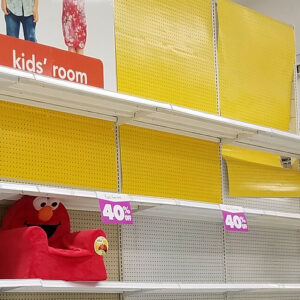For months, Americans have been battered by media coverage decrying disaster in the holiday supply chain. The intense focus on how supply chain constraints are affecting everything from Thanksgiving turkeys to Secret Santa presents implies that the situation won’t extend into the new year. But supply chain challenges aren’t going to end when the ball drops. They’ll be on the ballot in 2022.
Once invisible to consumers, the pandemic and holiday shipping crunch have unmasked the supply chain and made it a kitchen table conversation. A new Consumer Brands/Morning Consult poll of 398 registered voters in New Hampshire found that a majority (52%) of respondents said that supply chain issues have had a big or major impact on their ability to get products they need and nearly three-quarters (75%) reported experiencing shortages in grocery stores recently.
It would be a relief if the supply chain crisis were temporary. But while gift shopping and holiday returns will slow, there was record-breaking consumer demand before the holidays that will likely linger long after the last of the holiday decorations are put away — all while the supply chain struggles to catch up. Nowhere is that challenge clearer than in consumer packaged goods — the food, beverage, cleaning and personal care products that consumers depend on every day. CPG demand is off the charts. In the last four months, demand has risen above levels not seen since March 2020, at the start of the pandemic when panic buying took hold.
Expect consumers — and voters — to have a long memory on supply chain problems. Granite Staters have high expectations that they will see supply chain issues on their senators’ agendas in 2022: 93% say action on the labor shortage is important; 86% say tackling limited truck capacity and a lack of truck drivers needs to be on the list; and 83% expect to see port congestion further addressed.
There has been significant attention on the ports in recent months, offering a playbook for how government can play a role in easing supply chain pressure. However, too much focus on one link in the chain only serves to relocate bottlenecks, not solve problems. For the CPG industry that contributes $5.7 billion and 68,000 jobs to New Hampshire’s economy, increasing trucking capacity has the most potential to move the needle on the supply chain crisis. It has the potential to move the needle with voters too, as nearly seven-in-ten (68%) of New Hampshire residents report they are more likely to vote for candidates who support policies to increase trucking capacity.
The industry’s desire to grow trucking capacity is aligned with voter sentiment in the state. There is strong support from New Hampshire voters for near-term actions like increasing truck weights and giving drivers reasonable flexibility on start and stop times, as well as for longer-term ideas like funding recruitment programs to bring new drivers into trucking and creating an “air traffic control” system to match empty trucks with available loads.
The potential of the last idea would not only build capacity but limit the 35% of trucks making “empty” trips — that works out to 700,000 trucks. These trucks have the potential to carry nearly 40 billion pounds of freight — and that’s using current weight restrictions. Even if only a fraction of that potential were captured, it would have a tremendous impact on getting essential products to grocery store shelves. Fewer trips reduce the number of drivers needed, helping to chip away at the 80,000 (and counting) trucker shortage. It also has environmental benefits by lessening the environmental impact of trucks on the road.
It will take time and commitment to build something akin to air traffic control for trucks or to account for the number of new drivers needed in the trucking market. These are valuable concepts to pursue, but America’s current supply chain crisis does not have the luxury of time. It requires immediate solutions. In states like California, Ohio and South Carolina, governors have allowed for temporary increases to truck weights to create capacity and keep products consumers depend on from being snarled in supply chain backlogs.
We are at an inflection point where the supply chain’s vulnerabilities are exposed, and we have the choice to act on what we have learned. Weathering this crisis is difficult enough — we don’t want to be questioning why we didn’t do more if we face future supply chain crises. Commonsense trucking solutions will provide consumers with immediate relief and provide long-term improvements to the system.
Voters have exhausted their patience with years of government inertia. Elected officials can’t afford to lose sight of the supply chain after New Year’s Day — because its importance will not be lost on voters in the next election, which rings in right before the 2022 holiday season.





